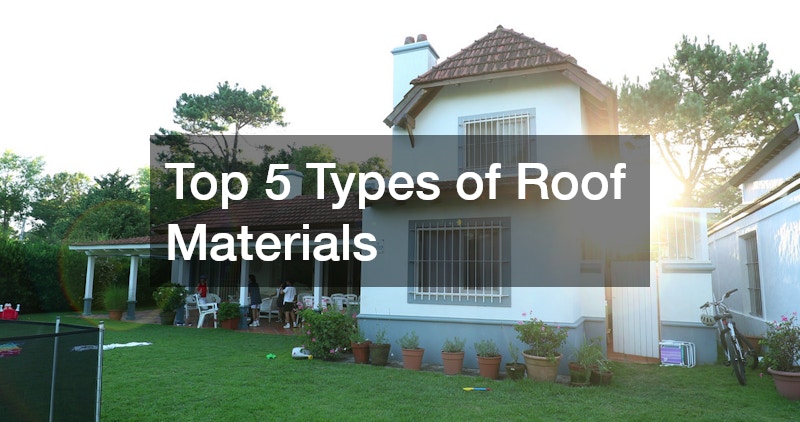
Selecting the right roofing material is crucial for ensuring the durability, aesthetics, and energy efficiency of a building. A well-chosen roof with the help of a local roofing contractor not only protects your home from external elements but can also significantly impact its overall appearance and environmental footprint. Homeowners have a wide array of roofing materials to choose from, each offering unique benefits and challenges.
What Are the Most Popular Roofing Materials?
Characteristics and Comparisons
Asphalt shingles are perhaps the most common roofing material, known for their cost-effectiveness and ease of installation. Metal roofing is praised for its durability and modern aesthetic, often made from recycled materials, making it a sustainable choice. Clay tiles offer a distinct look and excellent insulation properties, though they can be more expensive and heavier than other materials.
Wood shakes provide a natural and organic appearance, requiring regular maintenance to prevent deterioration from elements such as moisture and insects. Slate is a premium roofing material known for its elegance and longevity, often lasting upwards of 100 years with proper care, but it is one of the most expensive options available. Each of these materials offers a unique combination of benefits and drawbacks, making them suitable for different needs based on climate, budget, and style preferences.
Choosing the right roofing material involves comparing various factors such as aesthetic appeal, longevity, maintenance requirements, and environmental impact. By assessing these characteristics, homeowners can make informed decisions that align with their personal preferences and long-term goals. Ultimately, the selection of roofing material plays a significant role in the overall performance and satisfaction of a home’s exterior.
How Does the Cost of Roofing Materials Vary?
Cost Analysis and Budget Considerations
The cost of roofing materials can vary significantly depending on factors such as material type, quality, and installation complexity. Asphalt shingles, for example, are among the most affordable options, often providing a budget-friendly solution for homeowners. Metal roofs, while initially more expensive, offer savings over time due to their low maintenance needs and long lifespan.
Clay tiles and slate are generally more costly, reflecting their durability and prestigious aesthetic appeal. Factors such as regional availability, labor costs, and market demand can influence pricing, making it essential for homeowners to conduct thorough research before deciding. Budget considerations should also account for not only the upfront cost but the return on investment in terms of longevity and energy savings.
To effectively budget for roofing materials, homeowners should obtain multiple quotes from reputable contractors to ensure competitive pricing. Understanding the total cost of ownership, including maintenance and potential repairs, can help homeowners select the best material for their financial situation. Ultimately, cost considerations should align with the homeowner’s priorities, whether they be immediate savings or long-term value.
What Are the Environmental Impacts of Roofing Choices?
Sustainability and Eco-Friendly Options
Roofing materials can have significant environmental impacts, influencing a building’s sustainability footprint. Metal roofing, for example, is often made from recycled materials and can be fully recycled at the end of its life, making it an eco-friendly option. Clay tiles offer natural insulation, which can reduce the need for artificial heating and cooling systems, thereby minimizing energy consumption.
On the other hand, traditional asphalt shingles can contribute to landfill waste if not disposed of properly, although recent innovations have led to recyclable options. The production processes for some materials can also impact carbon emissions, making it important to consider a material’s lifecycle from creation to disposal. Therefore, homeowners looking for sustainable solutions should assess the entire environmental impact of their roofing choice.
Selecting eco-friendly roofing materials not only benefits the environment but can also result in financial incentives and savings. Some governments offer tax credits or rebates for sustainable renovations, including those involving green roofing solutions. By choosing materials with minimal environmental impact, homeowners can contribute to a healthier planet while potentially lowering energy costs.
How Do Roofing Materials Affect Energy Efficiency?
Energy Performance and Savings
The choice of roofing material can significantly impact a building’s energy efficiency, affecting both energy consumption and cost savings. Materials such as metal and clay tiles offer excellent reflective properties, reflecting sunlight and reducing heat absorption, which can lower cooling costs during summer months. Insulation ability is another critical factor, with materials like slate providing natural insulation that can help retain warmth in colder climates.
Asphalt shingles, particularly those with reflective coatings, can also contribute to energy savings by decreasing heat gain. Choosing the right color and finish can further enhance energy efficiency, as lighter colors tend to reflect more sunlight compared to darker hues. By considering the energy performance of roofing materials, homeowners can achieve a more comfortable indoor environment and reduce reliance on heating and cooling systems.
What Are the Maintenance Requirements for Different Roofing Materials?
Durability and Longevity
Different roofing materials require varying levels of maintenance to preserve their durability and extend their lifespan. Asphalt shingles typically demand minimal upkeep, though occasional repairs may be necessary to address issues such as curling or cracking. Metal roofs are renowned for their durability, needing little maintenance besides periodic inspections for debris or damage.
Clay tiles and wood shakes require more rigorous maintenance due to their susceptibility to moisture damage and biological growth. Regular cleaning and sealant applications can help prevent deterioration, prolonging their lifespan and maintaining their aesthetic appeal. Slate, while highly durable, can be vulnerable to cracking under certain conditions, necessitating prompt repairs to prevent further damage.
Choosing the right roofing material is paramount for enhancing the durability, aesthetics, and energy efficiency of a home. Each material offers unique characteristics, costs, and maintenance requirements that influence a homeowner’s decision. By carefully considering factors such as environmental impact, energy performance, and budget, individuals can select a roofing solution that aligns with their personal needs and priorities.

